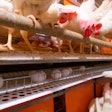The use of gradient or dynamic lighting intensities inside a broiler house can help boost flock performance and animal welfare. Creating a stratified lighting environment, as opposed to static lighting environment, that provides areas of high intensity and low intensity light allows the birds to better display natural behaviors.
Aaron Stephan, Ph.D., director of research and innovation for the animal lighting division at Signify, joins WATT Poultry Chat to discuss gradient lighting and how it can help broiler performance and welfare.
Elizabeth Doughman, editor, WATT PoultryUSA and Poultry Future: Hello and welcome to WATT Poultry Chat. I'm Elizabeth Doughman, the editor of WATT PoultryUSA and Poultry Future.
Today’s chat is brought to you by Once by Signify. Signify brings the science and benefits of dynamic lighting systems to your farm and your animals. Their dynamic lighting systems are based on decades of research and ongoing innovations as the global leader in agricultural lighting. Join Signify on the journey to ensure healthy growth and improve welfare of your animals.
Joining us is Dr. Aaron Stephan, Director of Research and Innovation for the animal lighting division at Signify.
Thanks for joining us, Aaron.
How is gradient lighting different from traditional boiler house lighting?
Dr. Aaron Stephan, Director of Research and Innovation for the animal lighting division at Signify: Traditional boiler house lighting was putting lights on the ceiling of the barn, spacing them out uniformly, with the goal of giving uniform light intensities across the floor of the broiler house. The goal of which is to achieve the same lighting conditions for every bird no matter where they are in the house.
So, if you walk around with a light meter measuring at chicken height, you'd expect or desire to have the same light intensity in foot candles or lux, say like 10 lux or five lux or whatever that number is. And if you see certain regions that had high light intensity, say like 20 lux and then regions of low intensity like two lux, that would be considered sub optimal in that case.
Gradient lighting turns that idea on its head. Instead of trying to achieve uniform lighting across the entire barn, you intentionally put regions of high light intensity and regions of low light intensity in the same barn, but in a predefined way.
When we're talking about gradient lighting, what we're actually talking about is putting lights on the feed lines of the broiler house, such that it creates little spotlights maybe about half a yard in diameter. Inside that spot, it could be very bright, say up to 150 lux of light intensity or 15 foot candles. And then outside of that that spotlight would be regions of low light intensity, say one lux or even lower at times.
So again, near the feed lines and certain feed pans would have high light intensity, and then it would gradient off and have lower light intensities elsewhere.
Doughman: Where did the idea of gradient lighting come from?
Stephan: This idea came from two different parts, one would be nature and one would be from science.
From the nature aspects, a chicken's wild ancestor, or relative is the red jungle fowl, which comes from the jungles of Southeast Asia. If you think about how sunlight interacts with an animal in that kind of environment, you know that most of the time they're not receiving uniform light. They're actually receiving vastly different kinds of light depending if they're walking under a bush or under the canopy of the rainforest.
If you Google search what rainforest sunlight looks like, you'll find a plethora of images that show dappled sunlight. Dappled sunlight is where some sun rays make their way through the canopy and give little spotlights of light throughout the rainforest floor. But, then the vast majority of the forest floor is actually quite dim, relative to direct sunlight. So that's the nature aspect.
But, then the science aspect actually started with some work over the years looking at how birds prefer which intensity of light. There's always been this debate of whether chickens should be receiving a lot of light or a little light and how much do they actually need.
One of the classical ways of looking at that is through what's called a choice experiment. There's a study done by Dr. Karen Christiensen, who is at the University of Arkansas, where she was performing one of these light intensity choice experiments where they were given a choice of high light intensity, low light intensity or medium and then they had a corridor where those chickens could move between those different light intensities. The goal was to see which light intensity do they prefer.
In the end, what they were saw was that those chickens were spending a significant amount of time in the corridor where they had access to different levels of light intensity. That sparked some ideas. These birds aren't really preferring a specific or any single light intensity, but they're actually preferring access to lots of different light intensities.
Over the next several years, Dr. Christensen and others were looking at this idea of providing choice to the birds. And it's kind of interesting that a lot of positive benefits were seen by providing these choices to the birds,
Doughman: What advantages are you seeing in terms of flock performance and welfare?
Stephan: From the bird side, it's really remarkable how much improvement you see by providing birds with with gradient lighting.
So the way it works is that since the lights are at the feed lines and the dim areas are outside the feed lines, the birds tend to like or prefer to go eat under the feeders and then go rest in the dark.
Again, equating this back to nature. If you're in a dim area, you're probably under a bush or somewhere sheltered and you feel safer and secure. But when you're eating, you're going out into the meadows searching for food.
We're seeing distinct behaviors that they're preferring to eat under the bright, resting under the dim, but we're also seeing an increase in lots of other natural behaviors, which are an indicator of positive welfare. For instance, dust bathing is one example where we see increased dust bathing due to provision of gradient light.
We're also seeing other bird indicators of positive welfare. For instance, improved leg health and we're seeing a reduction in fear responses.
And then interestingly, we're seeing an improvement in performance from the standpoint of feed conversion. The published studies on gradient lighting are showing on average three to four points of feed conversion. We've performed over 10 commercial trials throughout the United States and we also see consistently four points of feed conversion improvement.
In one study, which isn't published yet, Dr. Marian Dawkins from the University of Cambridge was looking at movement of these birds. They have a company called OpticFlock that uses movement as a as a proxy for bird welfare. And, in that case, what they saw is that movement is increased. And kurtosis, which is a measure of the uniformity of movement, is improved, which is again an indicator of positive welfare.
So those chickens are intentionally resting in the dark areas, moving to the light areas to eat and then going back to the dark areas to rescue again.
In addition to the positive performance and welfare that we're seeing, there's a number of other really interesting advantages that come by moving those lights off the ceiling and putting them onto the feed line. For instance, in order to do that, you can't use direct line voltage to power the lights anymore, so it moves to a DC powered system. And that makes the system quite a bit safer from the standpoint of risk of electrical shock or fire.
Also, because we're only providing a small fraction of the floor area with lighting, you can actually save significant energy costs total. So it's about 1/5 the energy usage in a gradient lighting situation compared to a ceiling or uniform lighting situation. This directly contributes to lower energy costs and improves the sustainability ratings for the integrator companies.
Doughman: Thank you so much for sharing these insights. For more information on the solutions discussed here today, visit Once by Signify at www.once.lighting.
Thanks again, Aaron, and thanks to you for tuning in.









